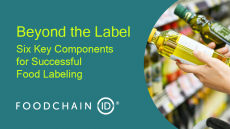Soup-to-Nuts Podcast: Demand for clean labels, increased sustainability are influencing package design

According to the CEO of the design and branding firm Crowdspring Ross Kimbarovsky, packaging that is unattractive, outdated or that fails to adequately communicate what is inside can result in missed sales as consumers pass over the products on store shelves.
In addition, he notes, a poorly designed package for one product could have a negative impact on sales for the overall brand’s portfolio if the packaging for one product sends the wrong message about the company’s values.
In this episode of FoodNavigator-USA’s Soup-To-Nuts Podcast, Kimbarovsky walks us through the importance of well-thought-out and executed packaging, as well as the top eye-catching design trends emerging in 2019, such as sustainability, minimalism, playful versus cause-friendly graphics and many more.
Three functions of packaging
Many people think the primary purpose of packaging is to protect the product inside, and while this is important, Kimbarovsky explains, that packaging serves three other purposes, all of which must be considered carefully in the design process.
The first is to communicate what the product is, since more likely than not it is hidden under a designer container. The second is to explain what the product does and the third is the value of the product to the consumer.
Failure to hit any of these three, will result in consumers shying away because they don’t understand the product or don’t think it is the right item for them, Kimbarovsky said.
Consumers want, and will pay more for, sustainable packaging
According to Kimbarovsky one of the biggest emerging trends in packaging design is sustainability, a value that is impacting the food and beverage space across multiple fronts
“Studies show that three out of four millennials and nearly the same percentage, 72%, of Gen Z will pay more for a product with sustainable packaging,” such as those made from recycled materials or that can be reused, he explained..
When approaching this trend, Kimbarovsky recommends that companies go big because smaller incremental changes, while helpful, are harder for consumers to detect and fully appreciate. For example, he notes, beverage brands that step fully away from plastic, rather than simply reducing the amount of plastic they use, more likely will be rewarded by consumers.
Minimalism is rising
Consumer interest in sustainability and waste reduction also is leading them to favor more minimalist designs, according to Kimbarovsky, who noted that this trend also is a reflection of the growing clean label movement related to food and beverage ingredient decks.
Also in response to a desire for a more natural, minimalist look is a growing preference for softer colors or basic black and white labels, he said.
Playful versus cause-related graphics
A minimalist look or toned-down color scheme doesn’t have to be boring. Kimbarovsky notes that there is still room for packages to feature playful designs, but he also warns that children today are much more sophisticated than previous generations and such might not be amused by the same elements that fascinated kids decades ago.
“One of the trends we see and will continue to see is playful package graphics, in part this is responding to the fact that we have younger consumers that are starting to dominate the marketplace,” he said.
But playful isn’t the same as it was in the 1950s or 1980s, which means trinkets in cereal boxes or crossword puzzles on the back of the box won’t cut it, Kimbarovsky said.
Rather, a better approach is an educational one that will help inform shoppers and users about the company’s values and tie the product back to macro trends, such as sustainability, he said.
Artisanal graphics gain traction
Another emerging trend in graphics is an increased focus on artisanal images that help communicate the authenticity of a product or that it is made with simple, recognizable ingredients.
“This is more of an effort to appeal to kind of authentic, local shop feelings,” and can be used to communicate if a product is free of an unwanted ingredient or low in calories or grain free, Kimbarovsky said.
It also ties into consumer concerns about how packaging might be impacting the quality of the product insides. For example, Kimbarovsky said consumers are concerned about plastic leaching into their food and beverages.
Demand for transparency is influencing packaging
Related to consumer demand for clean label products, is their desire to understand how the products are made and where they are sourced. And this trend is being translated literally in packaging with the increased use of cut-outs and windows.
Cut-outs are more expensive, but Kimbarovsky says they are worth it because they help consumers better understand what the product is and that the brand has nothing to hide.
A few others trends worth watching include the use of vintage designs that communicate a brand’s authenticity and authority, as well as the use of graphics rather than words to tell a story.





















